Turmeric Milk Recipe (Haldi Doodh)
Updated: August 18, 2023, By Swasthi
Turmeric Milk also known as Golden Milk is an Indian drink that has gained popularity in the western world in the last decade or so. In India, many consume this creamy and comforting drink at bedtime, and not just when they are unwell. Sometimes, a sweetened version is also given to kids to help them sleep better. In this post I share how to make turmeric milk (Haldi doodh), the traditional Indian way.
About Turmeric Milk
Turmeric Milk is a traditional Indian beverage made by mixing turmeric root and crushed long pepper known as pipli into hot or warm full fat milk. Also known as Haldi doodh, it is an age old ayurvedic remedy used to treat cold, congestion, cough, wounds, and other ailments.
The main compound in turmeric is curcumin. Piperine, the compound found in long pepper was believed to enhance the bioavailability of curcumin in turmeric. Traditionally fresh turmeric root is used to make haldi doodh.
Nowadays people prefer to add powdered turmeric (made from the dried root) and black pepper powder instead.
Sometimes other medicinal spices like cinnamon, nutmeg or ginger are added to the milk. Occasionally we also use this Chai Spice for a complex and more depth of flavors. Some prefer it sweetened with a bit of honey or jaggery. It is often served only with the goodness of pure turmeric powder or grated fresh turmeric root.
Golden milk is a warm tonic with spicy undertones meant to nourish, protect and has a pleasant taste. While many of us shared a love-hate relationship with this drink as kids. We have an acquired taste for it as adults.
Across the globe, health aficionados and people looking for alternative and natural remedies have begun adopting this milk drink. A form of cold and unsweetened turmeric tea is now consumed in Okinawa, Japan famous for its healthy and centenarian inhabitants.
Creative versions are turning up everywhere and some are far removed from the original turmeric milk tonic. You’ll find apple juice used instead of milk with ghee added in for good measure.
Someone in the US has even created a Indian meets Chinese health drink using turmeric and pepper powder along with goji berries and coconut butter in milk. Of course, you will find a dozen vegan and paleo variety of the classic haldi ka doodh with medicinal spices of choice.
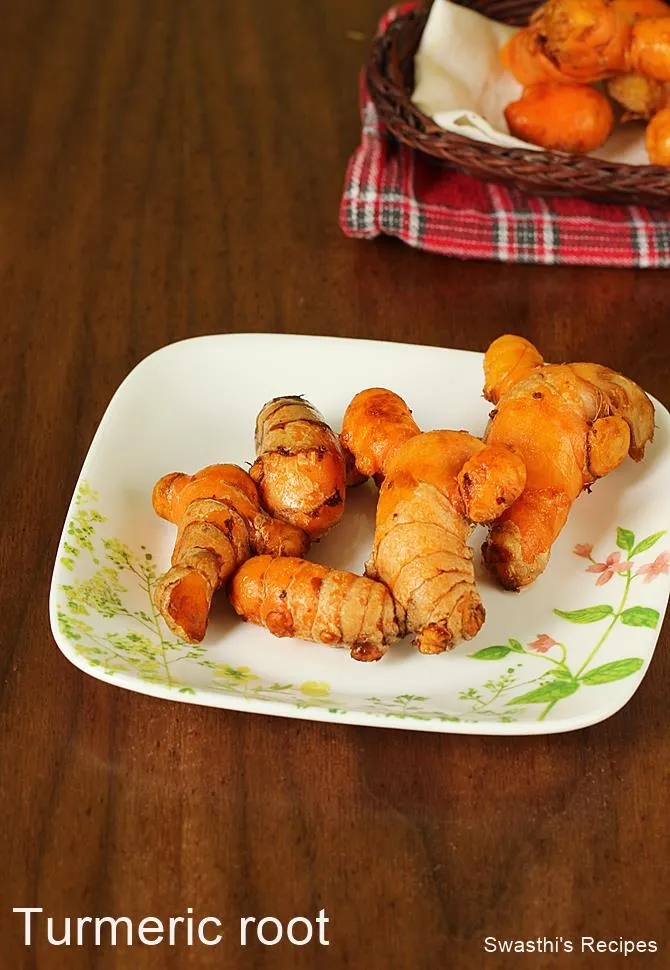
Why is Turmeric Milk special for Indians?
Turmeric has been used as medicine in India for over 5000 years. Archeological digs in Delhi found pots with traces of ginger, turmeric and garlic dating back to 2500 BC. From 500 BC, turmeric became an important medicinal plant under Ayurveda traditions. Burning turmeric and inhaling the fumes was considered beneficial for congestion and respiratory illnesses.
Ayurveda places high emphasis on both Sattvic – pure and simple foods and Ojas – vitality enhancing foods. Turmeric milk is considered to build and enhance this essential energy for a healthy body and mind.
Somewhere along the way, turmeric become an ingredient with spiritual and ritualistic value In Indian culture, and a popular culinary spice among savvy home cooks.
Even modern food scientists recommended warm milk as a comforting and sleep-inducing bedtime beverage. Haldi doodh takes this concept further with the addition of turmeric and medicinal foods.
Turmeric milk is simply one of the many ways Indians have included ayurvedic practices in everyday life, even thousands of years later. Turmeric, pepper, ginger and other healing spices and herbs are added to create a healthier diet and as proven home remedies.
Given the numerous benefits, golden milk has been a part of our childhood regime against colds and congestions, especially in winters.
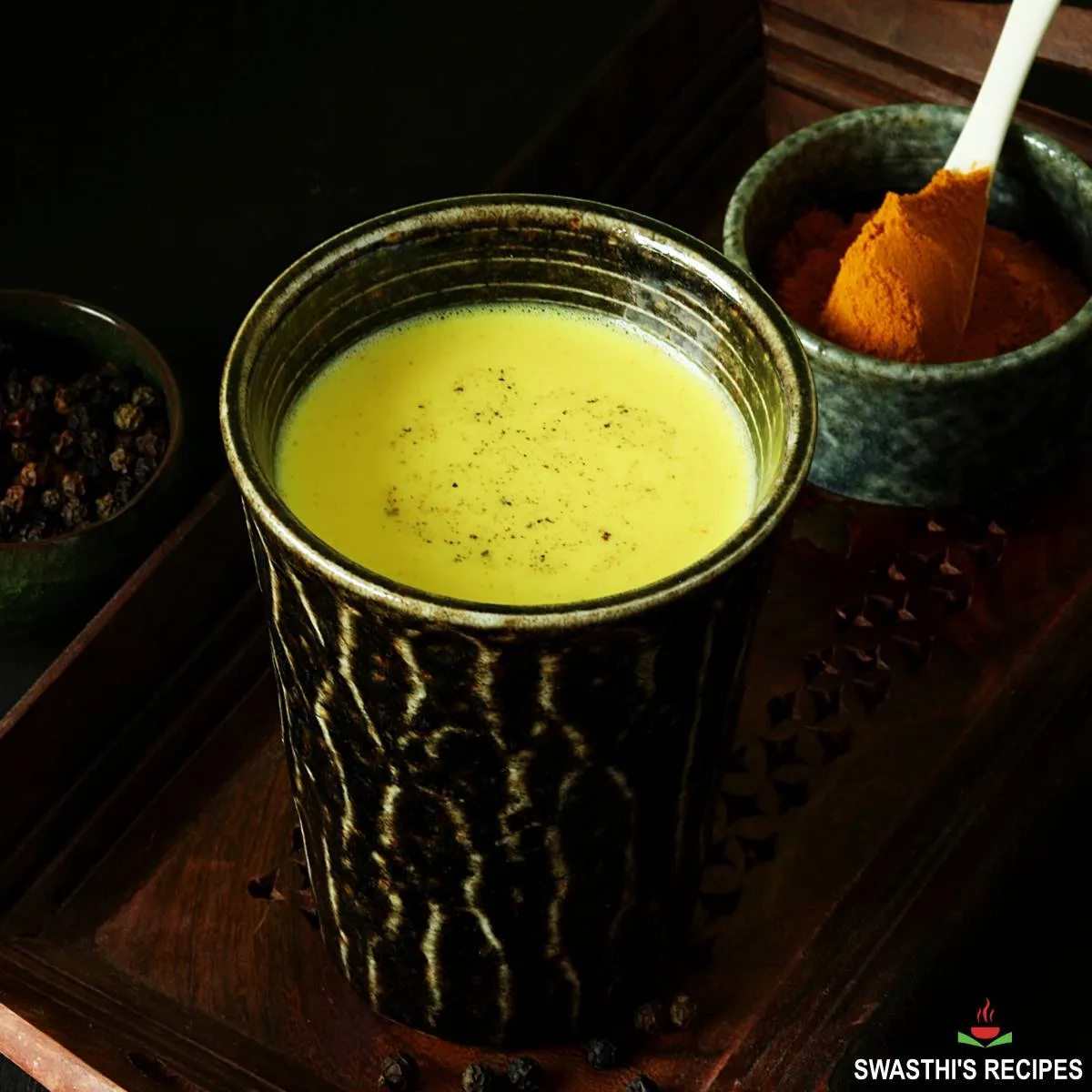
About this Traditional Recipe
There are numerous ways to make the soothing and frothy haldi ka doodh – plain, spiced, sweetened, not to mention, the increasingly cherished lattes and turmeric chai.
My recipe is very simple. It contains only 3 ingredients and is easy to make. Add healing spices like turmeric and pepper powder to warm whole milk (not very hot). Stir well and you’re good to go!
Why is whole milk used?
Turmeric is added to full fat (whole) milk to avoid dehydration because milk has a high hydration index. Indians consider turmeric milk to be safe for kids and toddlers too. This is presuming your kid don’t have any allergic reaction to haldi.
You can have this golden yellow-colored nourishing drink anytime you need an immunity booster or seek to brighten your mood. Serve it to kids and adults when they show symptoms of cold, cough or congestion.
So, let us get down to makes us some wholesome haldi doodh.
You may like
Turmeric Latte
Ginger Milk Tea (Adrak Chai)
Turmeric Tea
Badam Milk
Masala Chai
Photo Guide
How to make Turmeric Milk (Stepwise photos)
1. Bring milk to a boil. In India many people use raw milk, so the milk is boiled first. Though I don’t use raw milk, I prefer to heat the it as we believe boiled milk is easy for digestion.
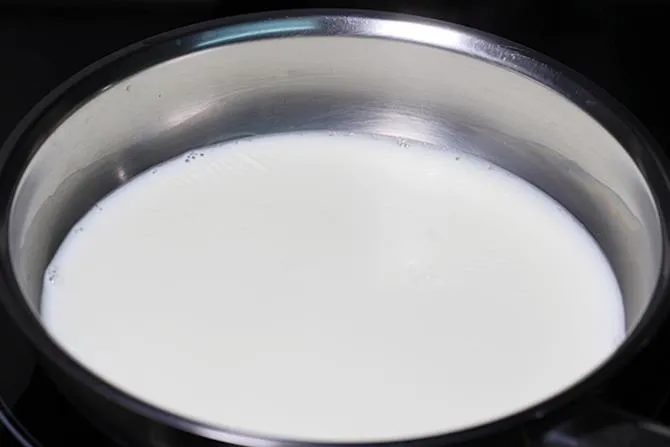
2. Allow the milk to cool down a bit. When the milk is slightly hot, add black pepper powder and turmeric powder or turmeric paste made from fresh root. My kids drink unsweetened milk, so I do not add any sweetener.
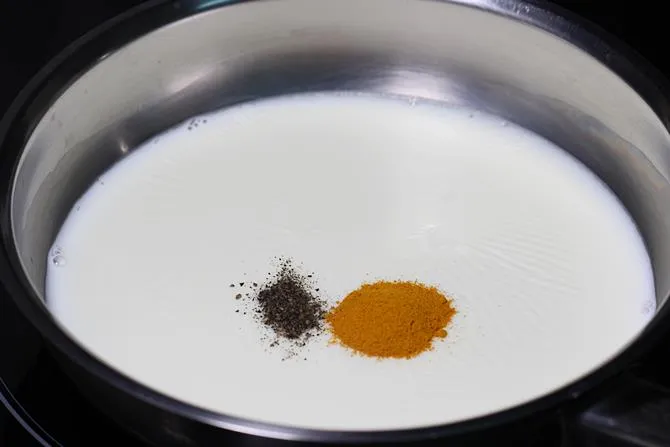
3. Stir well until the turmeric blends well with milk. Mix well with a spoon and transfer to a cup. I do not filter the cream or pepper, if you prefer you can strain the milk.
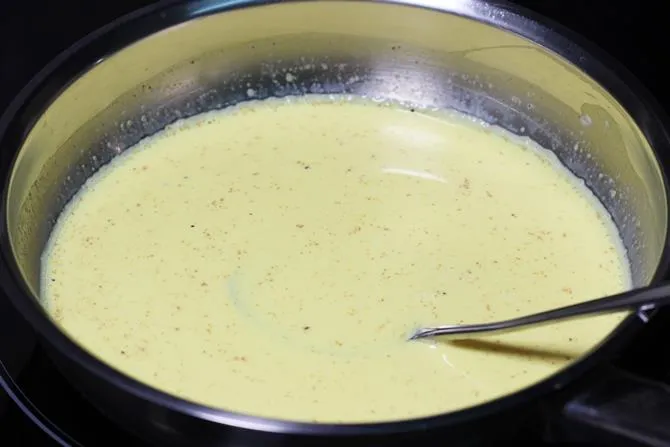
It is best to consume turmeric milk when it is warm preferably at bed time.
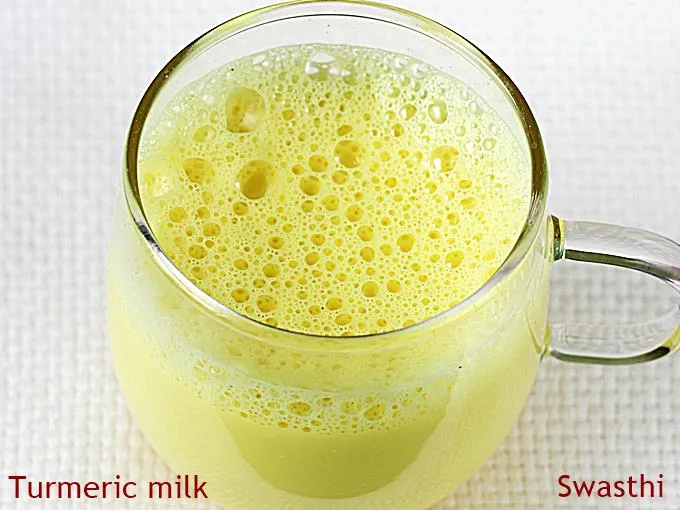
Pro Tips
- Always use organic turmeric powder or turmeric root and avoid chemically treated roots which are worse for our body.
- Fresh turmeric root is more effective than ground powder. But finding a organic fresh root is hard. If you are able to source it you can freeze it and use as and when needed within 3 months.
- You can grate the root and add it to hot milk and let it steep for a while. Then consume it. You can also filter it.
- To use the dried root, rinse it thoroughly. You can grate it and use or alternately rub it against a flat stone with few drops of clean water.
- Special flat stone tables are available which are used for rubbing sandal wood and turmeric root. You will get a smooth paste after rubbing the root for 5 to 7 minutes.
Faqs
Is golden milk the same as turmeric latte?
The classic haldi doodh or golden milk (made with regular or plant milk) is more of an immunity boosting drink. The turmeric latte that you find in Starbucks and other trendy cafes is a different beast. This sweetened concoction of frothy turmeric milk is poured over a shot of espresso.
While turmeric latte is a welcome change from sugary drinks, choose the simple golden milk to reap the nutritional rewards derived from milk, turmeric and added spices.
Can I add more spices to my turmeric milk?
Traditionally turmeric milk is made with just milk, turmeric and black pepper. But a lot of people also add many other crushed spices for flavor or for more suitability. Depending on your body condition you may use them. On occasions I also use this Chai Spice for a more complex and fragrant flavors. Here are some spices I have tried and tested with:
1 crushed Green Cardamom (or 2 to 3 pinches of ground cardamoms)
1 pinch of dried ginger (ground ginger)
1/4 inch piece cinnamon – 1/8 teaspoon ground cinnamon
1 clove (crushed)
Photo Guide
Recipe Card
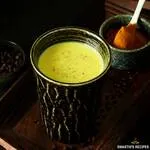
Turmeric Milk Recipe (Haldi Doodh)
For best results follow the step-by-step photos above the recipe card
Ingredients (US cup = 240ml )
- 1 cup whole milk (full fat milk from cow)
- ¾ to 1 teaspoon organic turmeric powder for adults, 2 pinches to ¼ tsp for kids
- ⅛ to ¼ teaspoon ground black pepper (or long pepper powder ),1 to 2 pinches for kids
Optional Ingredients (Read notes)
- 1 teaspoon organic sugar (jaggery or honey)
- ⅛ teaspoon ground green cardamom (or 1 crushed green cardamom)
- ⅛ teaspoon ground cinnammon (or ¼ inch Ceylon cinnamon)
- 1 pinch dried ground ginger (sonth/sonti)
- 1 clove (crushed)
Instructions
How to Make Turmeric Milk
- Traditional turmeric milk is made by bringing Cow's milk to a boil first. Pour milk to a pot and bring it to a gentle boil. If you want to use all the other optional spices, add them and boil for 2 mins. (read my notes below)
- Turn off and cool down the milk to a slightly hot temperature. Add ground black pepper (powder) and turmeric. Mix well.
- Transfer turmeric milk to a cup and consume while still warm. You may filter/strain the milk if you use other whole spices. Add sweetener if required. If using honey add it only when the milk comes down to warm temperature.
Notes
- In India, we believe that boiled milk digests easily so milk is always boiled before consumption.
- Turmeric milk works best when consumed warm. Consuming very hot turmeric milk can cause acidity.
- Traditionally turmeric milk is made with milk, turmeric and black pepper. No other ingredients are used. However for flavoring you may add the optional spices mentioned in the recipe but that is not the ayurvedic way. Every spice has a different effect on your body. Use cardamom for better digestion. Add cinnamon for its flavor and other benefits. Use clove and dried ginger for body warming properties.
- Also traditional Ayurvedic turmeric milk does not use sugar or any kind of sweetener. Use only if you can’t really drink without added sugar. If using honey, let the milk come down to warm temperature.
NUTRITION INFO (estimation only)
© Swasthi’s Recipes
Turmeric milk recipe was first published in September 2017. Updated and republished in February 2023.
About Swasthi
I’m Swasthi Shreekanth, the recipe developer, food photographer & food writer behind Swasthi’s Recipes. My aim is to help you cook great Indian food with my time-tested recipes. After 2 decades of experience in practical Indian cooking I started this blog to help people cook better & more often at home. Whether you are a novice or an experienced cook I am sure Swasthi’s Recipes will assist you to enhance your cooking skills. More about me
Follow Swasthi’s Recipes

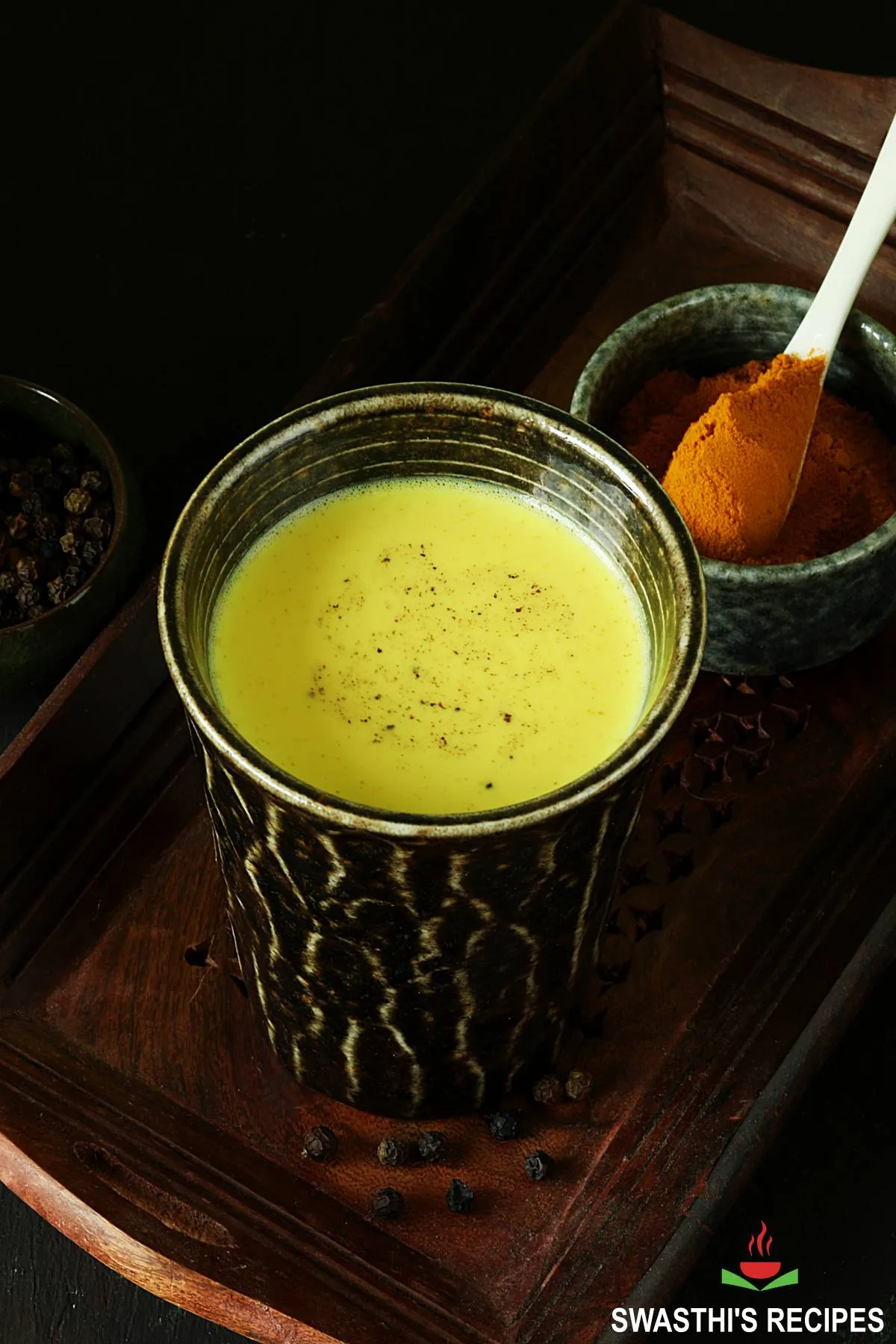
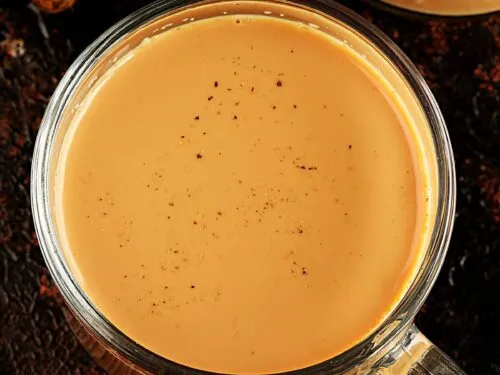
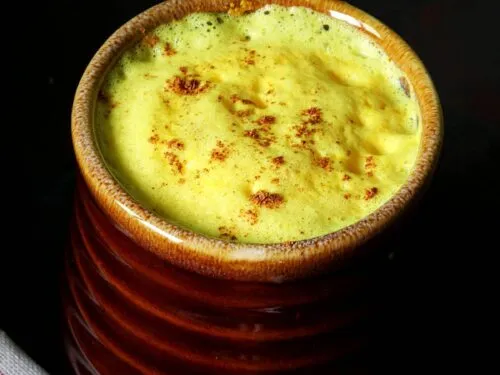
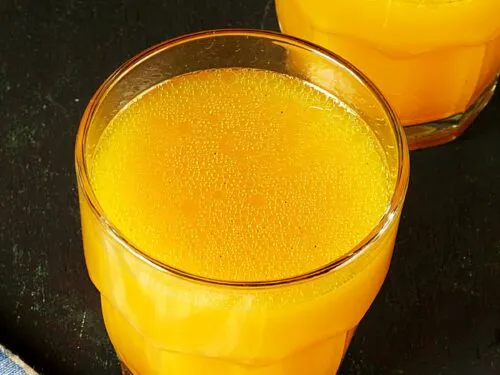
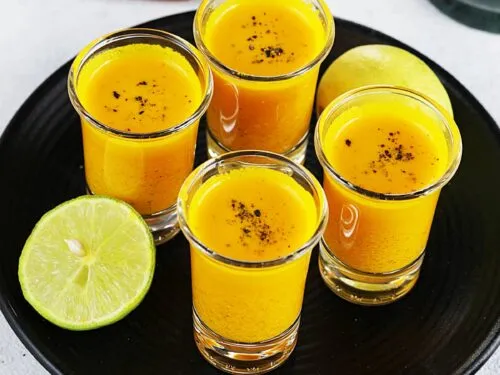
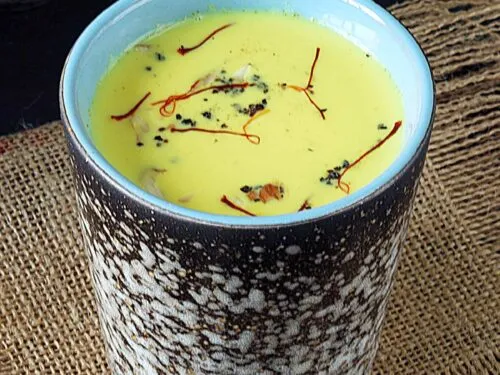
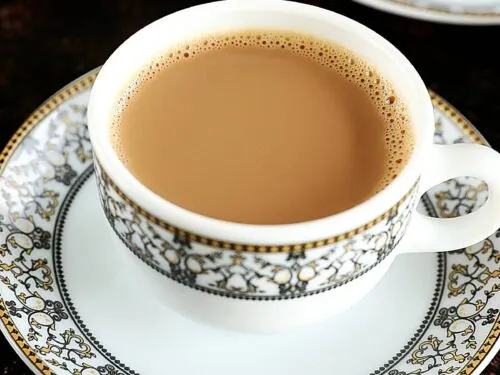
Comments
Informative
Quantity of each ingredient please and how long to boil
Bring 240 ml milk to a boil and stir in 3/4 teaspoon turmeric and ⅛ to ¼ black pepper. Mix well and serve. It is mentioned in the recipe card
Turmeric chelates iron and dairy blocks absorption. Not good if you have anaemia
Thanks for sharing that Catherine
Gud day how many times a day can you drink tumeric milk. I have bad influenza just want to know can i add a little cayene peper to my tumeric milk
Good Day Desiee,
You can have it twice a day but divide 1 tsp to 2 portions if you want to have it twice. Meaning use half tsp per serving. Using black pepper helps in better absorption.
I need to stay away from whole milk due to cholesterol. Can I substitute whole with almond or oat? Thank you!!
Hi Barbara,
Yes you can try with almond milk
Excellent recipe ?
This is a beautiful guide for a beginner like me. Made it today and loving it
Thank you for this very nice recipe. I have been looking for an authentic Indian recipe for Golden Paste: the paste used to make golden milk…or isn’t that an authentic version?
I have several recipes and yes, they do add ginger, ashwaghanda, cinnamon and cardamom…
Yes Carol. There is nothing called an authentic golden paste in Indian cuisine. You can make your own by following my Turmeric tea and turmeric latte posts.
I was in a Ayurveda retreat in Kerala many years ago. Got a recipe to make turmeric milk from them and have been enjoying it for long. A friend sent me this recipe and I’m surprised to see so many other spices. Gave a try and wow! just amazing flavors!
Yes the traditional recipe does not use any other optional spices. But a lot of people use these days for flavor. Thanks for trying Emma
Can I make a big batch of turmeric milk and just reheat it? How many days can you store it in the fridge? Thanks!!
Yes you can. But making fresh turmeric milk is just effortless. Heat up the milk and stir in the turmeric
Like the other commenter below I would love to hear your opinion on heating pasteurized milk. Is it really essential to heat the milk? Thank you
Hi Sandra,
A lot of Indians reheat pasteurized milk just to make sure the milk has not gone bad. It splits if it has gone bad. It is just a personal preference and most of us prefer this because don’t want to risk the kids. Indian turmeric milk is always served hot or at least warm for best results.
Hi Swasthi,
Thanks for the recipe. I use full fat pasteurised milk (which is already boiled and processed as it’s pasteurised!!) So does it require to boil again? -when I boil this processed milk again it leaves residue at the bottom of the pan. And I read that the residue is nothing but some coagulated proteins from milk- so is it necessary here to boil the milk? As while boiling I’m actually loosing some nutrients at the end. In India, they boil the milk because it’s raw and from local farmer/vendor. So it’s understood but how about well processed pasteurised milk?
Thanks for your time and knowledge!!
Hi Bin,
I have been using pasteurized milk for the past 20 years and always boil before consumption. According to ayurveda we believe warm or hot milk is better for digestion and absorption of nutrients. Once in a while cold milk is okay otherwise warm is preferred for regular consumption. Regarding the coagulated proteins – that happens because the fats in the cold milk settle at the bottom of the pot and sudden hot temperature causes it to get stuck. If you bring the milk to room temperature and then heat, this won’t happen.
I have been drinking golden milk for many years now. I could only see a little improvements with my arthirits. Last week an Indian friend sent me some fresh turmeric roots and that changed the game. I am in for a week now and can see 50% improvements. Those who want to make turmeric milk for healing use fresh turmeric root. It is more beneficial. However I would request the author to mention the quantity of fresh turmeric root to use. I also checked your turmeric shot and going to give it a try when I want to limit the dairy.
Thanks for sharing your experience. The quantity of turmeric root to use depends on the health condition of individuals. It is best to consult a specialist to arrive at a proper dose. 5 grams of fresh turmeric root is fine for healthy and normal people. This is the quantity we use at home. Hope this helps.
Thank you for your most invaluable recipe!
I intend to use soy milk, instead of dairy milk. Is it possible?
And is it necessary to bring the mixture to a boil. Or can I just stir all the ingredients together, without boiling?
Please advise, thanks!
Hi,
It is good to have it warm if you have cold or related symptoms. You can stir the turmeric and pepper to little hot water. Then add soy milk to it. Hope this helps
I loved and addored all your information and i certainly will try both the tumeric milk (now when I learned form you who to make it) which I were after for a long time, and also the massala tea
Thank you so much.
Yes do try them
Can you recommend a good non-dairy milk alternative for a vegan version – for an adult with a cold?
Hi RuTu
You can try with sesame milk. For 1 cup sesame seeds you can use about 3 cups water and blend. It makes a little over 3 cups milk. 150 to 200 ml of this milk per day is fine to use. Add turmeric to hot water. Then stir in to the sesame milk. Hope this helps.
Hi Swasthi,
If we are using organic raw turmeric, how much we should put it? I normally grate a small portion of the turmeric and put it. Can you suggest if I am proceeding the right way?
Thanks & Regards,
Saharsh
Hi Saharsh Taneja,
1/8 tsp of grated raw turmeric is fine for 2 yrs. If you make a paste like the way I mentioned in the post, then you will have to halve it. Yes you can continue the same way you are doing. But do you think the grated one is working well. I was told to make a fine paste as it absorbs well especially for small kids.
Thanks a lot Swasthi.Ok,now I got it, you have recommended the dosage when given it as a medicine.Actually i’ve heard that it can given every week even when not having cold or cough coz that will boost the immune system. So was planning to give entire winter season max 3 days per week alternatively. So can i give her this milk for 3-5 days consecutively when she has cold And then every week for 3 days alternately once she has recovered? What if she doesnt recovers in 5from cold and cough when taken given consecutively?should we continue or stop giving it?
5 days***
When given***
Hi Teena
Yes you are right. As a preventive measure to cold I think thrice a week should be okay. During cold with turmeric milk if you do not see recovering in 2 days & 1 night, you should see a doctor. It may not be good to wait any longer as long as 5 days is not good. Most kids develop infections by 3 to 5 days during cold season. Seeing the doctor in time can prevent the consumption of antibiotics. Hope this helps.
Thanks a lot dear.
hi Swasthi,
my daughter who is 4 years old seldom drinks milk and that too with sugar. So can I add sugar with Haldi and pepper? Secondly, am thinking of giving her max 3 alternate nights in a week coz I’ve heard too much is not gud ,for this winter .u had recommended 5 to 7 days for 4 years and above, that means 5 -7 days in a week? and the amount to be 1/4th of a teaspoon every time I give her ?This is what I could make out of this blog. Please correct me dear if am wrong. And does the efficacy of this milk reduces if the milk cools off ?coz my kiddo drinks so slowly that max times she ends up drinking cold milk.
Hi Teena
Yes if she doesn’t drink then add little sugar. As i have mentioned in the post too much is not good and may dehydrate. 1/4 tsp is if she has completed 4 yrs. My experience is it has to be taken at least for 3 consecutive nights other wise it will not work. The symptoms will return after missing the next dose. But yes if the symptoms improve after 1 st dose then you can halve the dosage meaning 1/8 tsp and continue for 3 to 5 days. 7 days is for 7 yrs old. Yes warm milk works best. Cold milk doesn’t get digested and leads to phlegm. You can put the milk cup in hot water when ever she takes a break. Milk will warm up again. Give her lot of warm water as well.
this is good…please keep it up